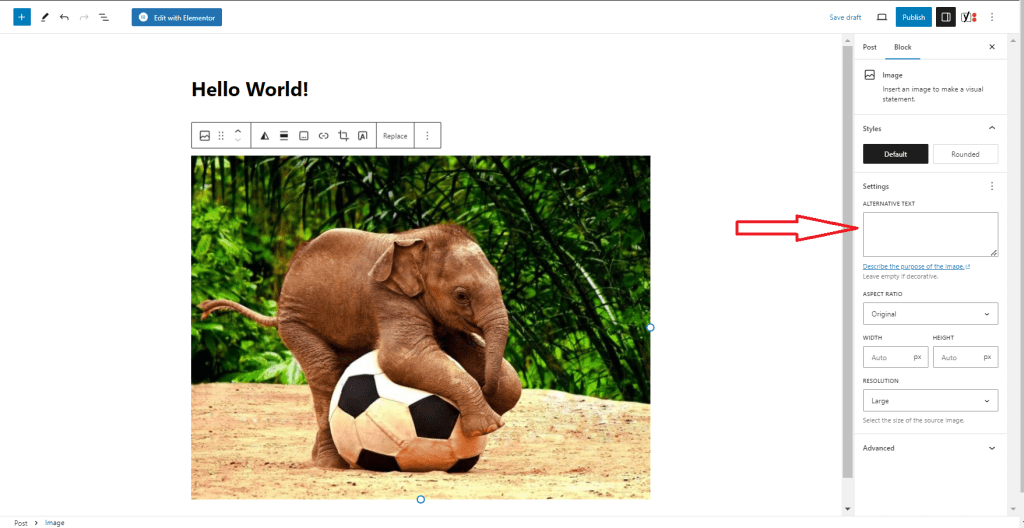In the world of web design and search engine optimization (SEO), there are many elements that play a pivotal role in enhancing the user experience and boosting your website’s visibility on search engines. One such element that often goes unnoticed but is crucial for accessibility and SEO is “alt text.” Alt text, short for alternative text, is a concise description of an image on a web page.
In this comprehensive guide, we will delve into the world of alt text, exploring its meaning, importance, best practices, and how it can significantly impact your SEO efforts. So, let’s embark on this alt text journey together!
What is Alt Text?
Alt text, also known as alt attribute or alt description, is a brief text description that provides alternative information about an image on a web page. This description is read aloud by screen readers to assist individuals with visual impairments in understanding the content of the image. Additionally, alt text serves as a fallback option for browsers that cannot display images and is displayed when the image fails to load.
Why Alt Text is Important?
Now that we understand what alt text is, let’s delve into why it’s such a crucial element in web design and SEO.
Accessibility
Alt text is vital for making your website inclusive and accessible to everyone. It ensures that individuals with visual impairments can understand and engage with the content on your site. By providing descriptive alt text for images, you contribute to a more inclusive web environment.
SEO Enhancement
Search engines like Google use alt text to understand the content of images on a web page. When you optimize your alt text with relevant keywords, you improve your chances of ranking higher in search engine results pages (SERPs). This can drive organic traffic to your website and increase your online visibility.
How Do I Write Good Alt Text?
Crafting effective alt text requires a blend of creativity, relevance, and conciseness. Here’s a step-by-step guide on how to write compelling alt text:
Be Descriptive
Alt text should succinctly describe the content and purpose of the image. Imagine you’re explaining the image to someone who can’t see it.
Use Keywords
Incorporate relevant keywords related to the image and the surrounding content. This helps search engines understand the context of the image.
Avoid Keyword Stuffing
While using keywords is essential, avoid overloading your alt text with them. Keep it natural and user-friendly.
Conciseness Matters
Alt text should be concise, usually under 125 characters. Brevity ensures that screen readers don’t read overly long descriptions.
Skip Redundancy
If the image is purely decorative and doesn’t add meaningful information, you can use empty alt text (alt=””). This tells screen readers to skip the image.
Alt Text Uses
Alt text serves various purposes on a website. Here are some common scenarios where alt text comes into play:
Content Images
Alt text for content images should provide a clear and concise description of the image’s relevance to the content.
Product Images
In e-commerce, alt text can include product names, numbers, and essential details to help users understand what’s being offered.
Icons and Buttons
Alt text for icons and buttons should convey their functions. For example, “Search” for a magnifying glass icon or “Read More” for a button.
Complex Images
When dealing with complex images like charts or graphs, provide a concise summary of the visual data.
What Does Good Alt Text Look Like?
Let’s explore some alt text examples to better understand what effective alt text looks like in practice:
Here are the images along with examples of good and poor alt text for each:
Example 1

Poor Alt Text: “Cat“
Good Alt Text: “Tabby cat sitting on a windowsill looking outside“.
Example 2

Poor Alt Text: “Chart“
Good Alt Text: “Pie chart illustrating the distribution of a company’s annual expenses, with sections for salaries, rent, marketing, and utilities.“
Also Read: SEO Glossary Unveiled: 480+ Crucial Terms Every Marketer Should Understand!
How to Add Alt Text to Your Images
Now that you know the importance of alt text and how to craft it effectively, let’s discuss how to add it to your images:
HTML Markup
In your HTML code, locate the <img> element for the image you want to add alt text to. Within the element, include the alt attribute and provide your alt text as its value.
html Copy code <img src="image.jpg" alt="Descriptive alt text goes here">
Content Management Systems (CMS)
Most CMS platforms, such as WordPress, offer a user-friendly way to add alt text when uploading images. Look for an alt text field in your CMS’s media library or image upload tool.

Image Editing Software
If you’re editing images before uploading them to your website, you can often add alt text directly in the image properties or metadata.
How Alt Text Helps SEO
Alt text plays a vital role in enhancing your website’s SEO. Here’s how it contributes to your SEO efforts:
Improved Ranking
Search engines like Google consider alt text as a ranking factor. When you optimize your alt text with relevant keywords, your images and content become more discoverable in search results.
Enhanced User Experience
Alt text helps visually impaired users navigate your website effectively. By providing an accessible experience, you improve user satisfaction, which indirectly affects SEO through factors like bounce rate and dwell time.
Image Search Optimization
Alt text is essential for image search results. When users search for images related to your content, well-optimized alt text increases the likelihood of your images appearing in these results.
In conclusion, alt text is a small yet mighty element of web design and SEO. It not only ensures accessibility for all users but also enhances your website’s visibility in search engine results. By following best practices and crafting descriptive alt text, you can harness its power to improve your website’s performance and user experience. So, don’t underestimate the significance of alt text—it’s an essential tool in your SEO arsenal.
FAQs
Alt Text should be concise yet descriptive. Include essential information about the image, such as its content, function, and context within the webpage. Avoid using generic phrases like “image” or “image of” unless necessary.
Yes, some best practices include keeping Alt Text under 125 characters, using proper grammar and punctuation, and avoiding redundant information already present in the surrounding text.
No, it’s crucial to provide Alt Text for every image on your website. Leaving it empty or blank can make your site less accessible to users with disabilities.
For decorative images that serve no informational purpose, it’s best to use empty or null Alt Text (alt=””) to indicate that the image is purely decorative.
You can use web accessibility evaluation tools and screen readers to test the Alt Text on your website. Many online tools and browser extensions are available for this purpose.
Failing to provide Alt Text can result in a less inclusive and accessible website. It may also lead to legal compliance issues, as some countries have regulations requiring web accessibility.
While Alt Text is most commonly associated with images, it can also be used for other non-text content like graphs, charts, and multimedia elements to ensure their accessibility.
